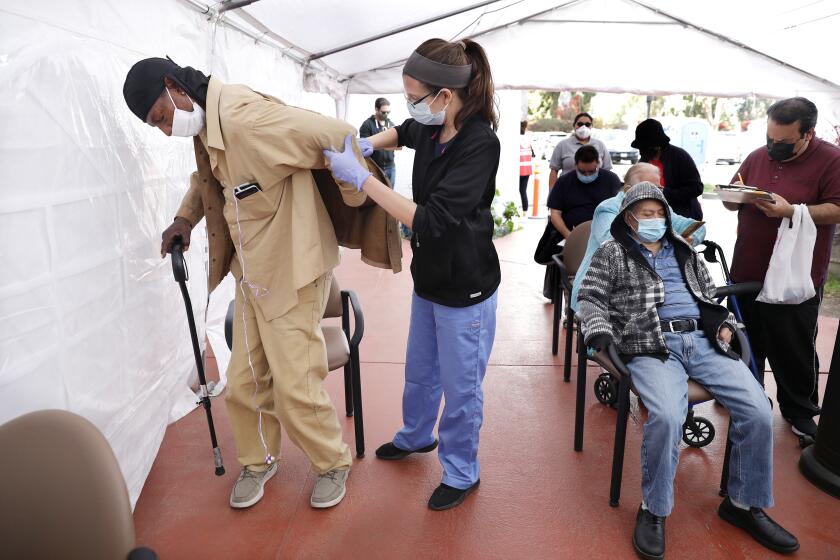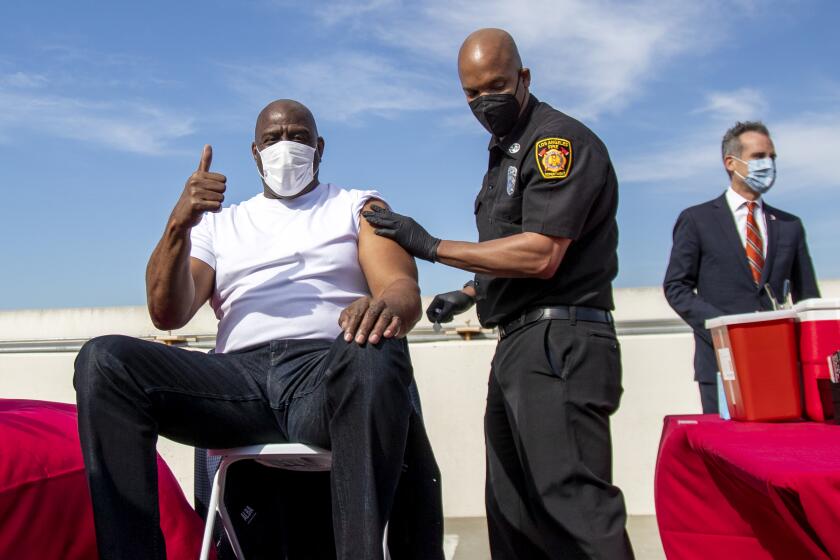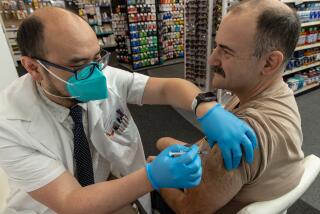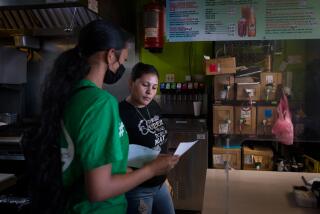These community workers are key to the stateâs vaccine strategy
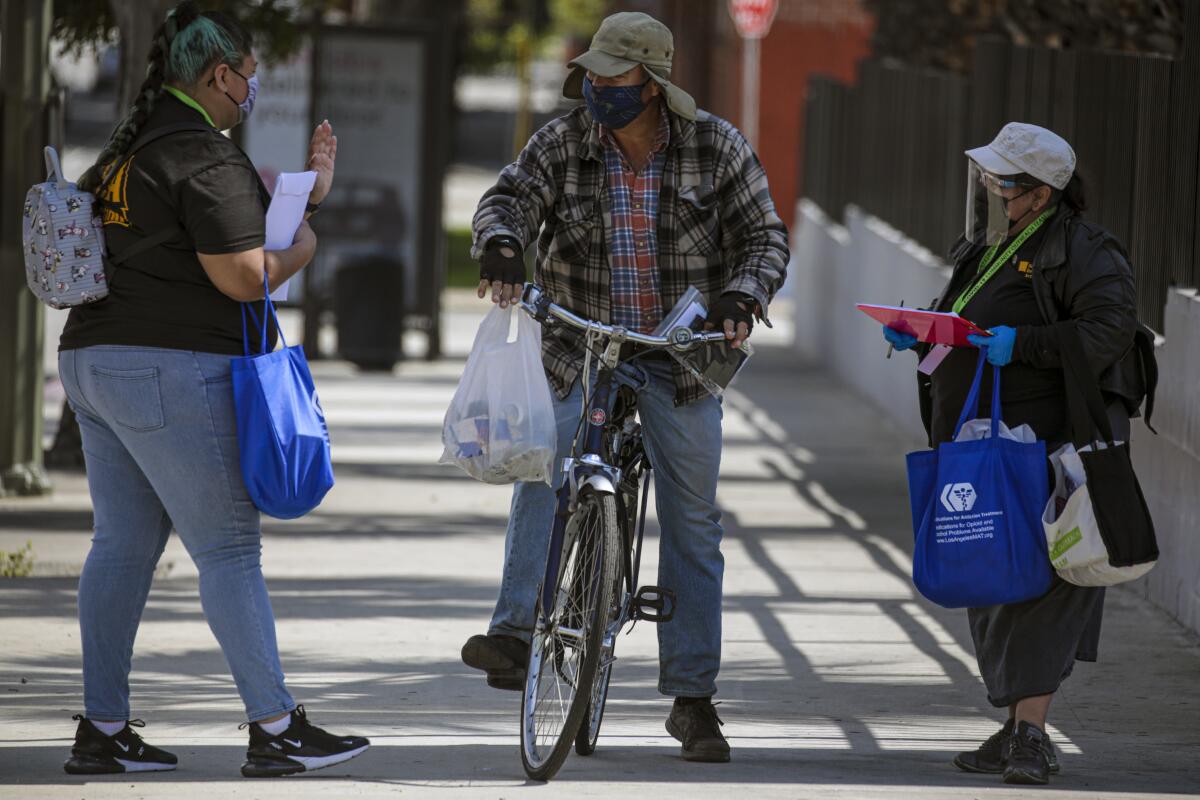
Armed with a clipboard and a face shield, Maria Mejia takes off running through the Food 4 Less parking lot in Boyle Heights.
Few people escape the 53-year-old outreach worker without hearing her straight talk about the COVID-19 vaccines. Not the grandfather of one heading for his car, not the young store employee, not the woman unloading bags into her trunk, not even the maskless man who told her he didnât need her advice.
Over the last two months, Mejia and her work partner Susan Salcido, 29, have walked the streets, alleys and storefront thoroughfares across East Los Angeles and Boyle Heights to make sure residents, shopkeepers, taco vendors, virtually anyone who crosses their path, are aware of everything they need to know about the vaccines.
Mejia is the Spanish speaker; Salcido reaches out in English and, occasionally, sign language. Together they check peopleâs eligibility, share information about the facts versus myths of the virus, and take names to register people for a shot.
âWeâve talked to hundreds of people,â Salcido said, as she headed out of the parking lot to another store across the street. âI think in a day, face to face, especially in an area like this, we could get more than 200.â
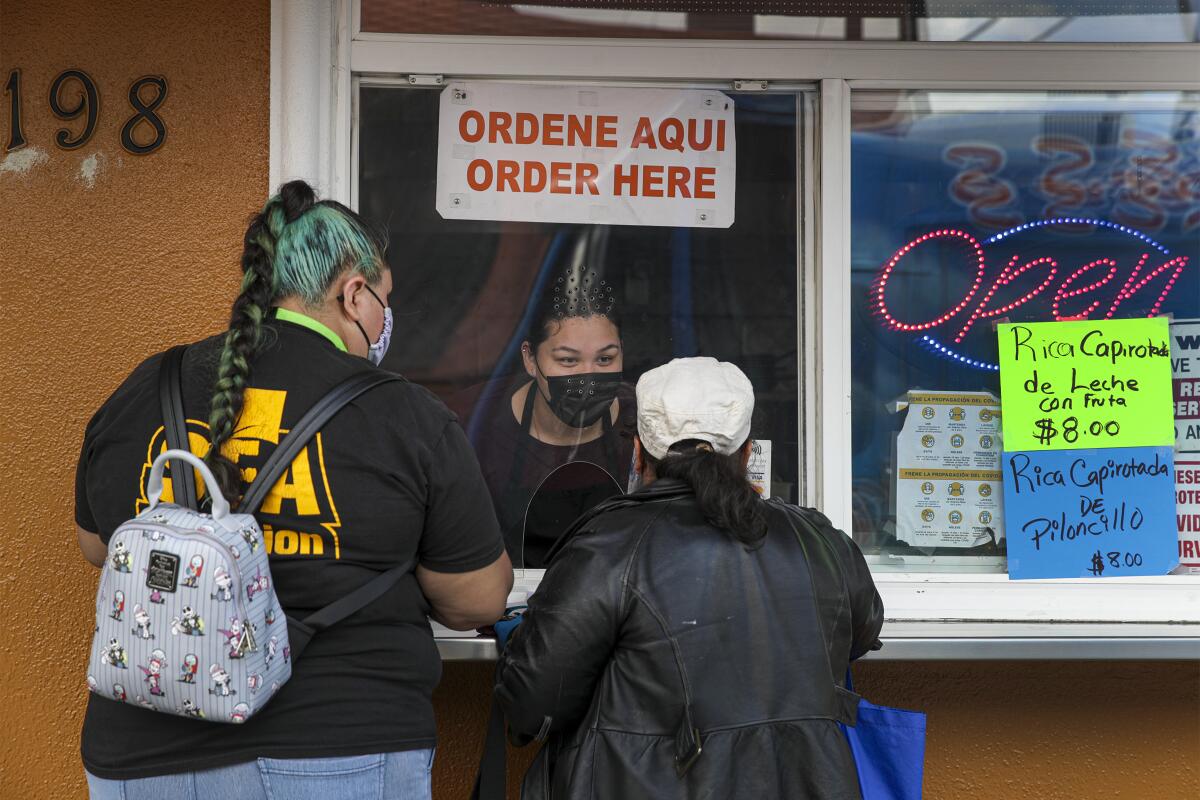
As California opens vaccine eligibility to anyone older than 16 in weeks to come, outreach efforts to communities hardest-hit by the pandemic will remain a crucial part of the stateâs strategy. Forty percent of all doses will still be allocated to 400 ZIP Codes, East L.A. and Boyle Heights included, that have suffered disproportionately from the pandemic.
The state has enlisted hundreds of community groups â including college sororities and local nonprofits â to get the word out. In L.A. County alone, more than 50 groups have mobilized workers for virtual and on-the-ground outreach. The efforts have reached hundreds of thousands of people in 82 neighborhoods from Chinatown to South L.A., according to public health officials.
Mejia and Salcido work for Soledad Enrichment Action, an educational nonprofit for disadvantaged youths, and are among the small army of outreach workers who address persistent misperceptions about the virus and the vaccines in predominantly Latino communities. Reluctance to take the vaccines continues to be a problem, as well as access to accurate information amid a deluge of ever-changing messages from the state.
âThis is for the sake of the future,â Mejia tells the people she meets.
In the race to improve vaccination rates in Californiaâs most vulnerable areas, community groups are leading the charge.
SEA, before the pandemic, focused on educating young people and at-risk families. But as COVID-19 cases spread, the organization shifted its mission.
L.A. Countyâs Department of Public Health gave SEA dozens of vaccine registration slots and so far the group has registered more than 160 residents. They have also shared vaccine information with more than 67,000 people throughout the communities of Palmdale, South Gate, Watts, South San Gabriel, East L.A. and Boyle Heights
Salcido knows this area well â sheâs from East Los Angeles. Many of the businesses she visited are places she grew up frequenting. The job is personal for Mejia too. A former high school biology teacher, she has worked nearly 15 years as a teaching assistant at SEA.
Each day, the pair covers as much ground as possible inside a target area mapped by the county health department. SEA, with its dozens of workers, is responsible for reaching nine ZIP Codes in Boyle Heights and East Los Angeles. The communities have been hit hard by the pandemic â East Los Angeles has accounted for more than 24,690 cases and Boyle Heights has accounted for more than 17,260 cases, which includes cases attached to correctional facility outbreaks. The areas have been a major priority for the countyâs vaccine efforts.
On a recent rainy day, Mejia and Salcidoâs task is to work on covering the 20-block area between Olympic Boulevard and the Santa Ana Freeway, and Spence and Indiana Streets. For hours, they traverse the city blocks on foot, carrying with them bags filled with face masks and informational fliers.
After they leave the Food 4 Less supermarket lot, they head to an intersection nearby. They stop at a burrito truck on Olympic Boulevard and ask the owners inside if they need a COVID-19 safety flier for their window and whether they are getting the vaccinations. They wave down a man on a bicycle to offer information about the vaccines, then cross the street to help a homeless man seated outside the post office sign up for a shot.
Nearby, a family of four waits for their food outside a Mexican seafood restaurant. Cynthia Herrela, 27, tells the pair that her 67-year-old mother, Rosa, has just been vaccinated â a relief for Herrela, who contracted COVID-19 last March. Herrela got it, her mother got it, her brother got it, even her 2-year-old son got it. The only person who was spared was her husband.
As Mejia and Salcido leave, the owner of the barbershop, a 54-year-old woman, waves them down. She wants to know if she and her husband are eligible for a vaccine.
After a quick interview reveals underlying health conditions, Mejia pulls a pen from behind her ear to take down the womanâs name and phone number to help her register the following week.
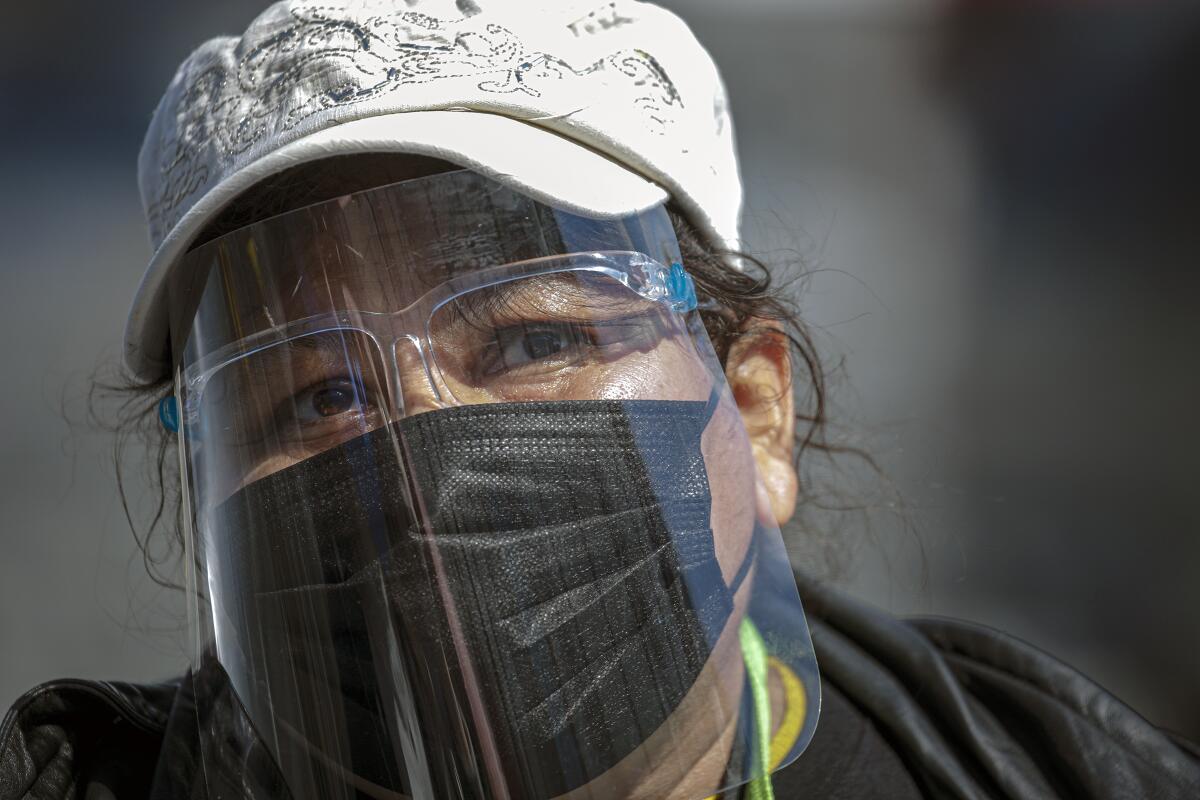
Mejia and Salcido head into a residential area, where they hang fliers on peopleâs fences as dogs bark at them. Outside one house, a woman tells them she doesnât think she can get a vaccine. She is disabled and doesnât have medical insurance, and her husband is in the country without legal status. How will they qualify?
âTheyâre not going to ask about that,â Salcido assures her. âWe donât need to know that information.â
The answer seems to provide some relief to the 50-year-old woman.
âIâm glad you guys are doing this. I was worried,â she says.
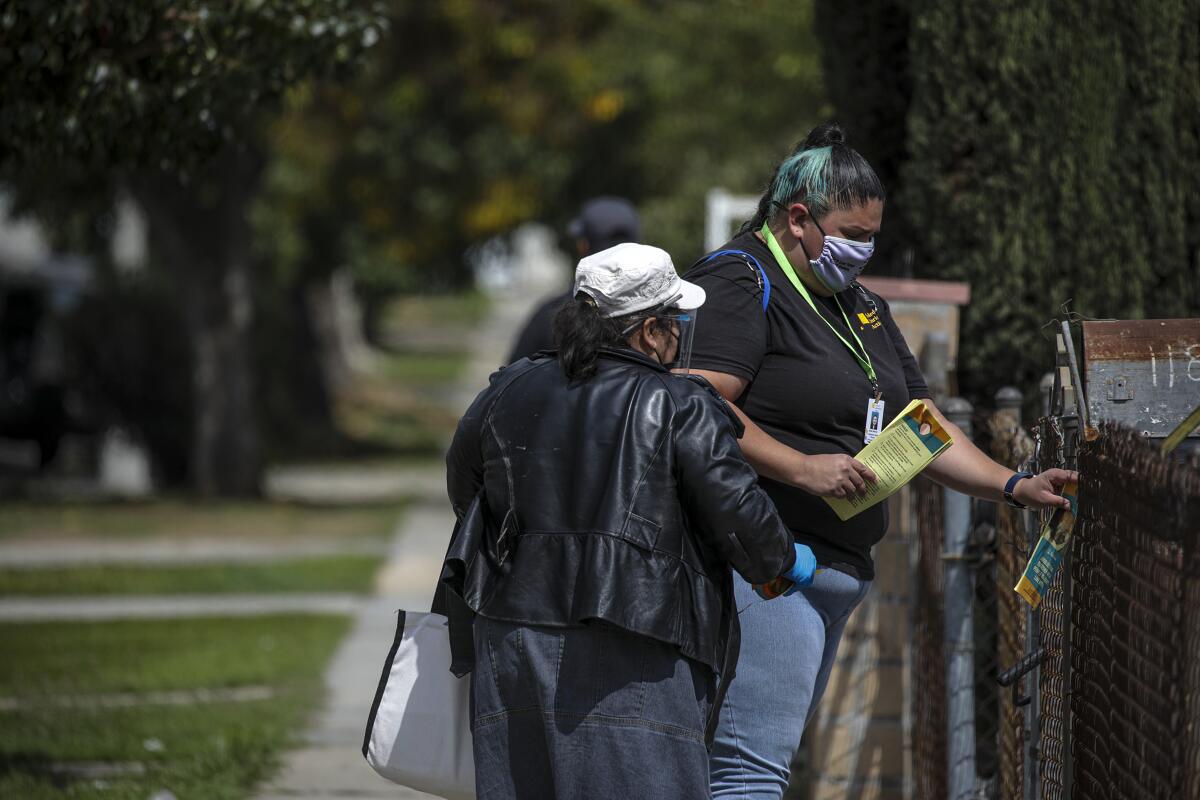
Salcido and Mejia continue down the street. Both women had COVID-19 last year and have since been vaccinated. Itâs not uncommon for them to share their individual experiences with people they meet along the way.
As rain clouds gather above, Mejia waves from the sidewalk to an older man seated on his front porch. Does he need information about the vaccine? She asks.
No, he shouts back, pulling down his mask with a smile. He already got it.
We traveled around the L.A. region to ask people whether or not they would take the vaccine, and if not, why. Then we posed their questions to two experts. Hereâs what they said.
More to Read
Sign up for Essential California
The most important California stories and recommendations in your inbox every morning.
You may occasionally receive promotional content from the Los Angeles Times.
